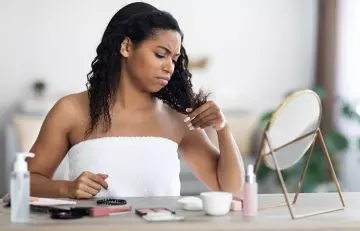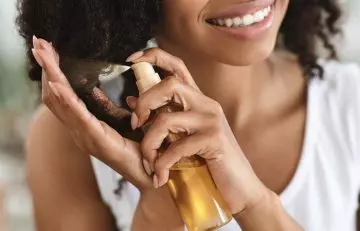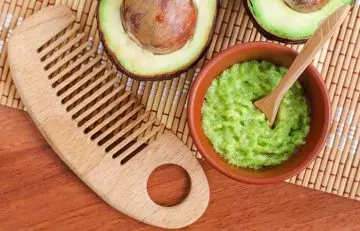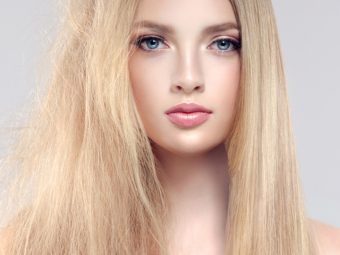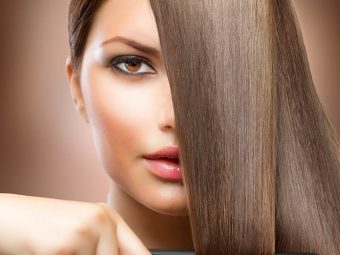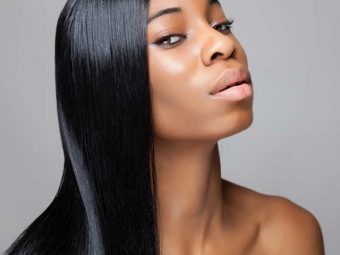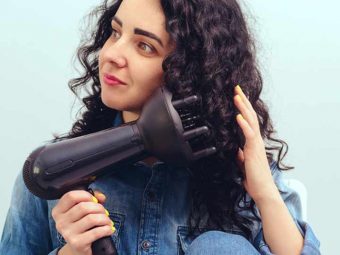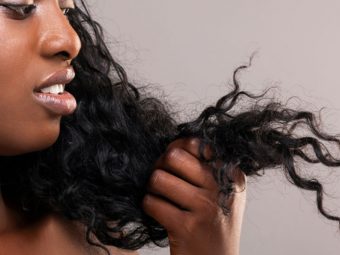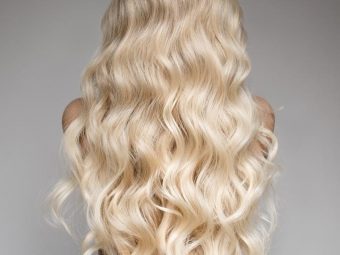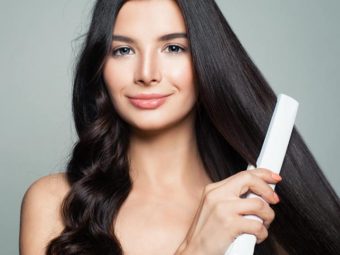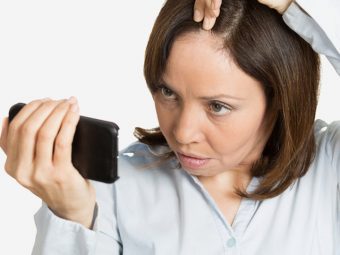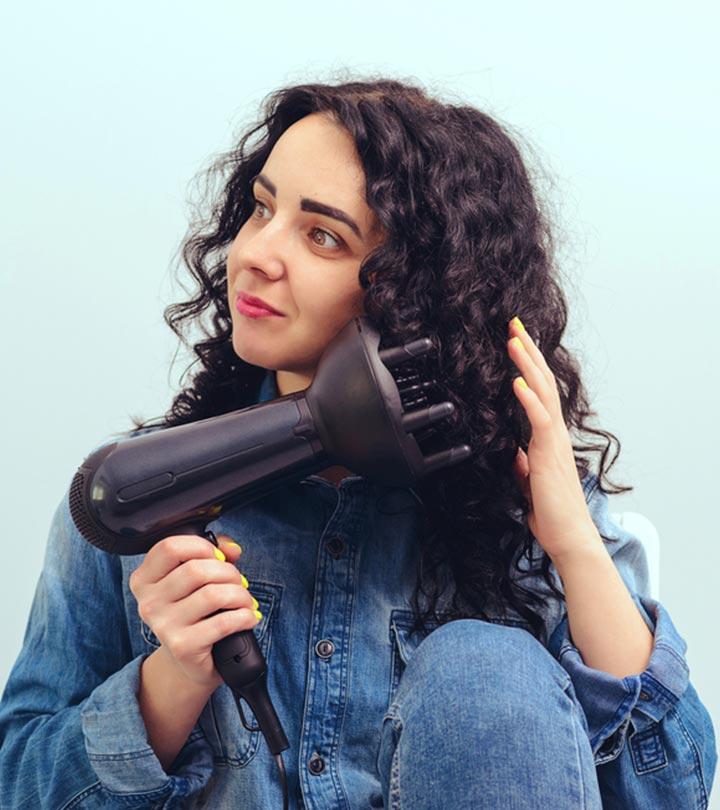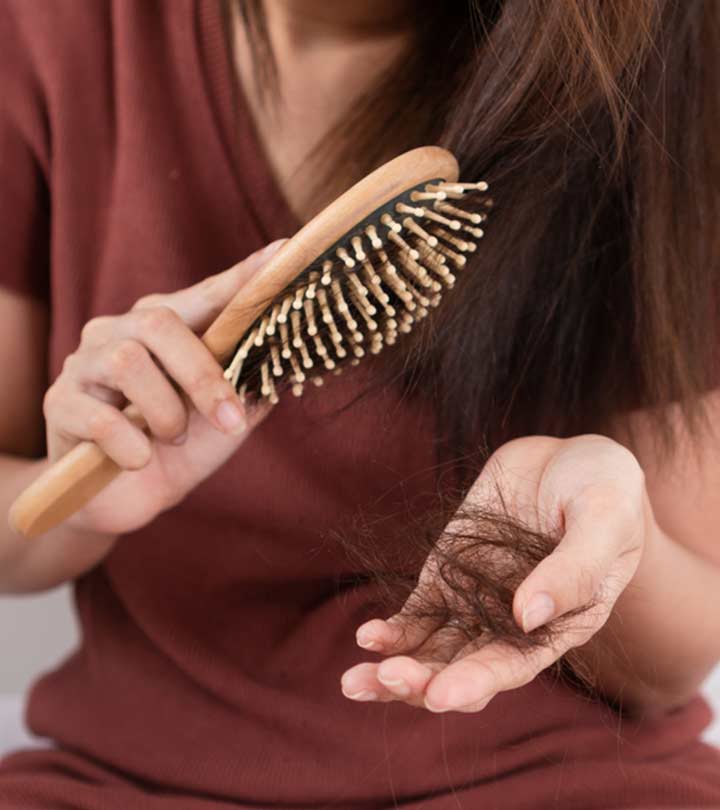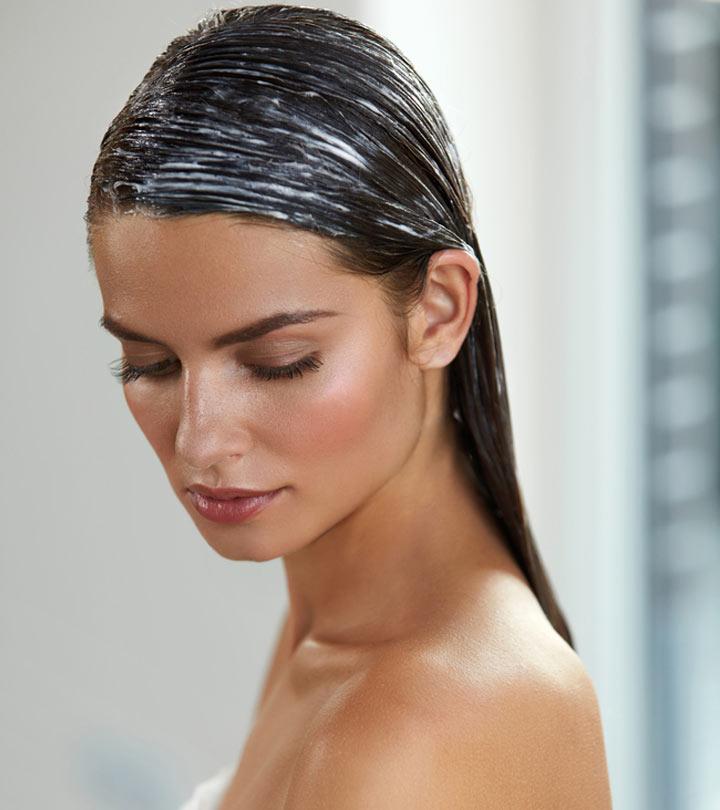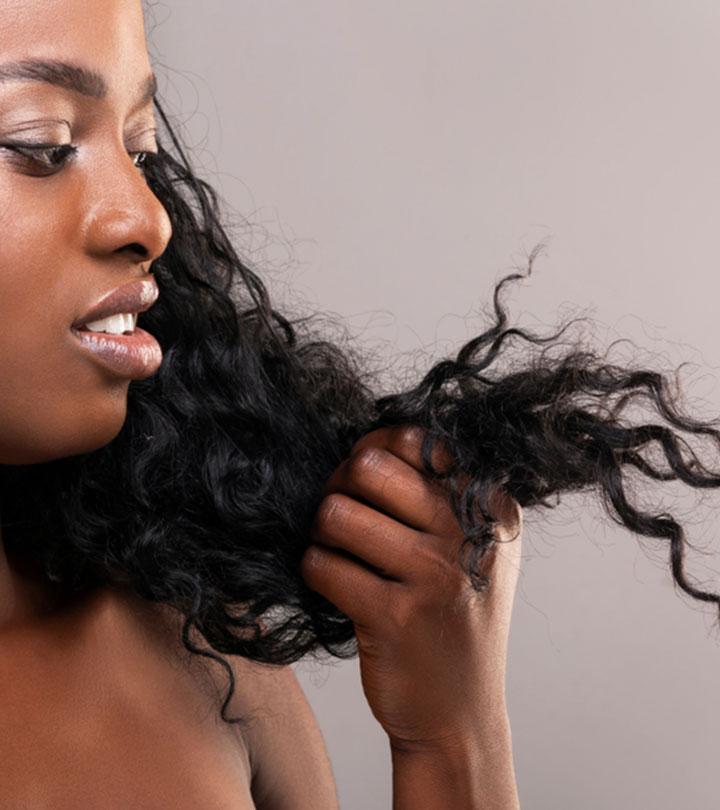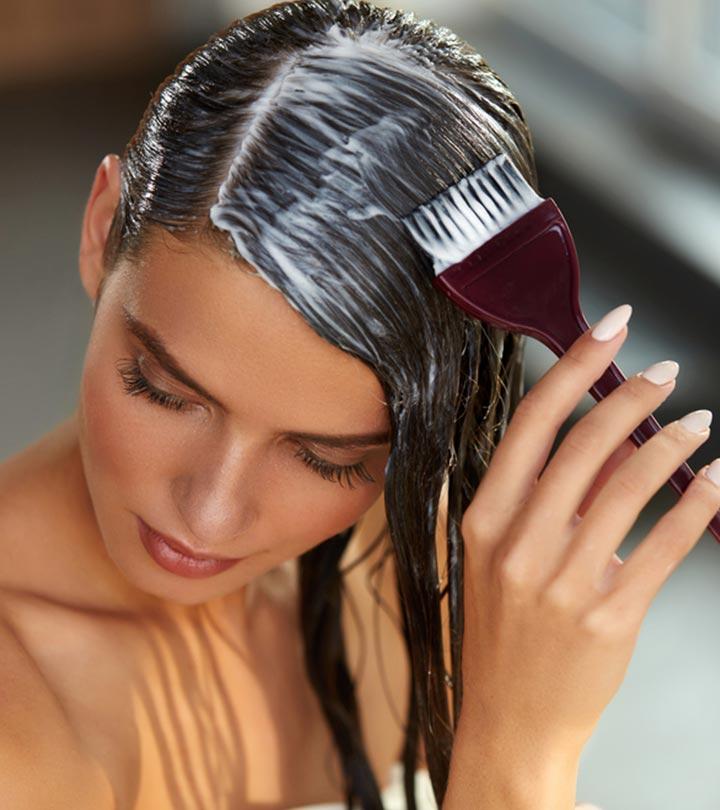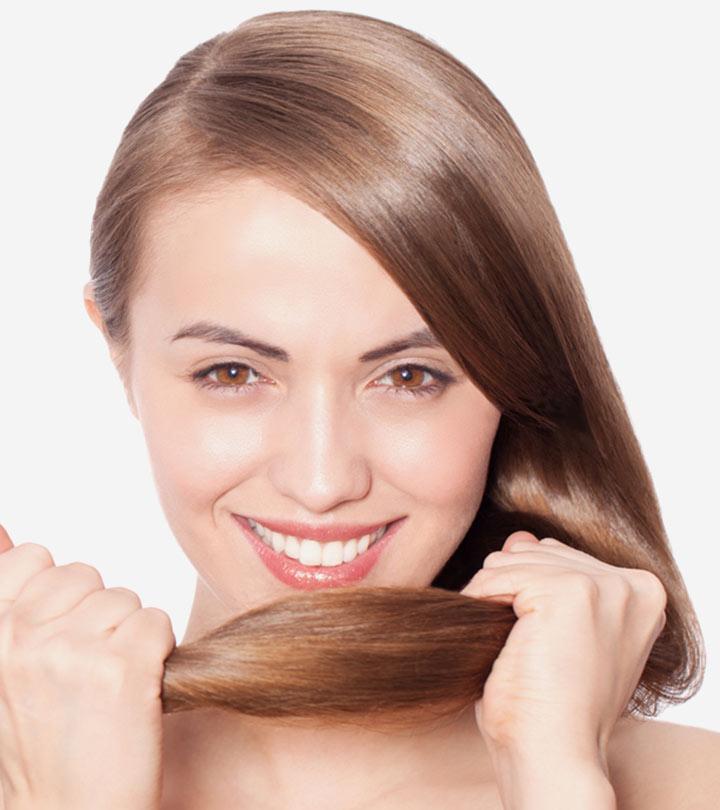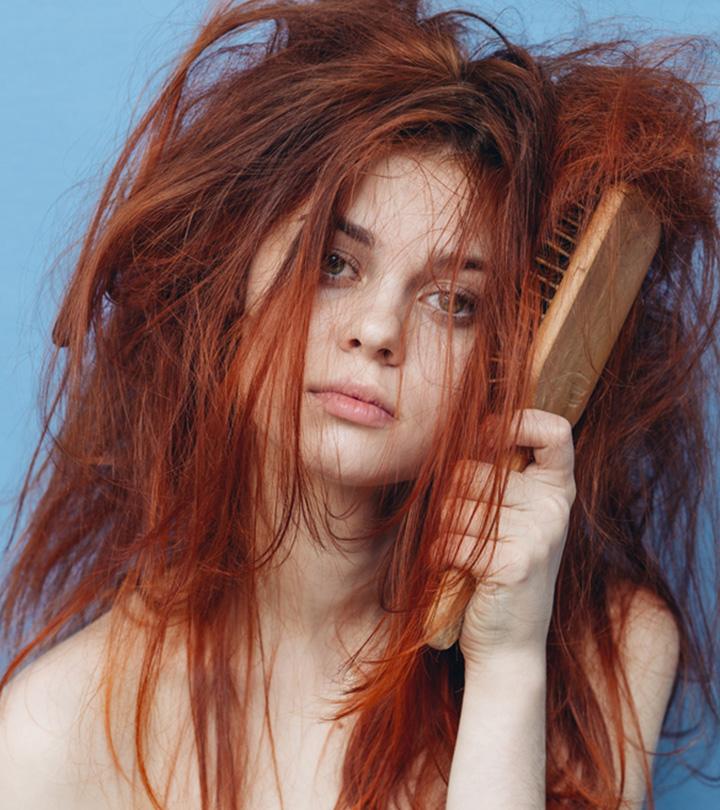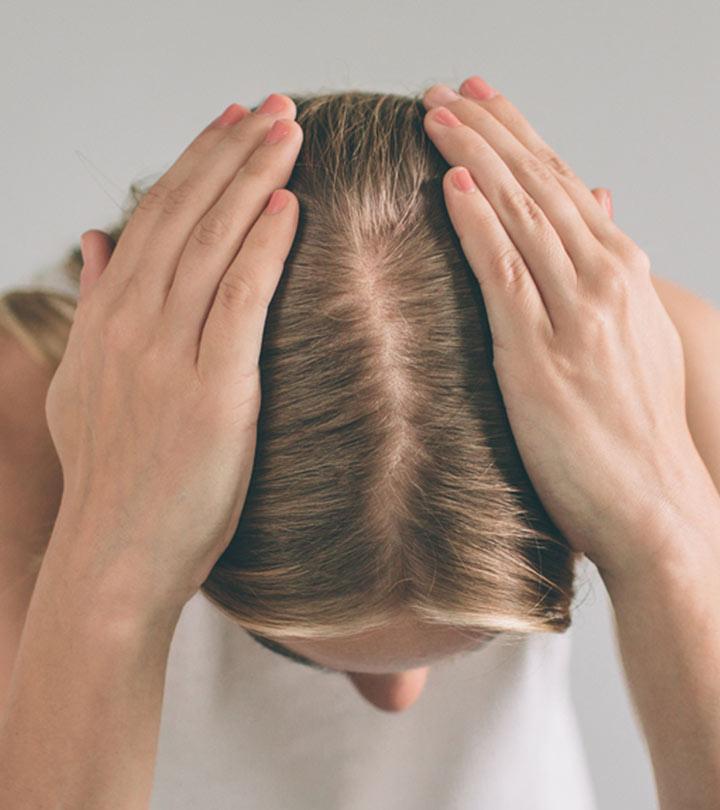How To Get Natural Curls Back After Heat Damage
Repair your precious locks with simple, affordable, and effective remedies.

Image: Shutterstock
Heat-damaged curly hair can be tough to manage, and many cut or trim their hair to grow their curls back. But these curls may not be bouncy and break easily and might leave you with damaged, frizzy hair with split ends. Here is where some natural remedies and tips come to the rescue. Read this article to learn the step-by-step process of using natural remedies to manage heat-damaged curls and ways to get back your natural bouncy curls. Scroll down.
In This Article
How Does Heat Damage Hair?
Heat may damage hair in several ways, primarily by altering its structure and reducing its moisture content. The hair cuticle weakens and may even break when exposed to high temperatures from styling tools like flat irons, curling irons, or blow dryers (1). This may result in frizz, split ends, and a rough texture. Excessive heat may also strip the hair of its natural oils and make it dry and brittle.
In case your hair is damaged, timely action can help. But how do you know if you have damaged curls? Certain signs can tell. Learn more in the next section.
Signs You Have Heat Damaged Curls
Before you recover your damaged curls, it is important to figure out if your curls are heat-damaged because relaxers and other chemical treatments also cause damage. Here’s a list of signs to look for to confirm heat damage:
- Your Hair Texture Is Rough
Rough and dry hair is the first sign of heat damage. Heat styling tools like straighteners and blow dryers tend to dry out the natural oils and open the hair cuticles, which makes it impossible for your hair to retain moisture. Without moisture, your hair becomes dry and extremely rough.
- Your Hair Is Too Weak
Curly hair is already weaker than straight hair. Frequent use of heat styling tools without a thermal protectant makes it worse. You can tell your hair is weak if you are experiencing severe hair loss or hair breakage.
- Your Curls Have Lost Definition
The worst thing to happen to your curls! When curls lose definition and get stuck somewhere between wavy and frizzy, it makes your hair look unkempt, malnourished, and in urgent need of help.
- Your Hair Ends Are Very Dry
One of the quickest ways to tell whether your hair is heat-damaged is by looking at the ends of your hair. Split ends, dryness, and discoloration are the main signs. The hair ends can feel extremely rough and dry to the touch.
- Your Hair Has Lost Luster
Since high heat strips your hair of its natural oils and opens the cuticles, it becomes tougher for the hair to retain moisture. As a result, your curls can rapidly lose luster and shine.
- Your Hair Is Hard To Color
Heat damage also makes the hair strands tough to color. Moreover, if your hair is heat-damaged, it is best to wait it out until you tackle this problem and then color your hair.
- Knots And Tangles
Heat styling may cause dryness, leading to tangled and knotted hair. This happens because the hair’s cuticles become rough and brittle, and make your hair more prone to breakage. Always be gentler while combing your heat-damaged hair as putting mild strength in detangling the knots might lead to more hair loss.
If you think your hair is heat-damaged, here’s how to restore your hair health due to chemical treatments and environmental stressors. But, if the above-mentioned signs sound familiar, your hair is heat-damaged. Scroll down to learn how to repair your curls from heat damage.
How To Repair Heat-Damaged Curly Hair
- Get A Hair Spa Treatment
Hair spa treatment works really well for restoring hair health and reducing heat damage. The steam creates a micro humid environment that helps the moisture to penetrate deep into the hair shaft. Applying a hair moisturizer and massaging the scalp also helps revive the hair follicles and strands. Washing your hair with cool water closes the cuticles, thereby allowing the hair to retain moisture. It is better to get a spa treatment twice a month for the first two months. Continue getting the spa treatment once a month after the second month.
- Try Hot Coconut Oil Treatment
Apart from getting a spa treatment, you must also take care of your hair at home. It is one of the best and easiest ways to add nourishment and moisture to dry and heat-damaged curls. Take 2 tablespoons of coconut oil and heat it up for 10 seconds. If it’s too hot, let it cool down a bit. Use your fingertips to massage your scalp gently with the warm coconut oil. Apply it to your hair strands as well, concentrating more on the ends. Put your hair up into a bun, wear a shower cap, and wait for 30 minutes before washing it. Do this twice a week to boost your hair health.
 Did You Know?
Did You Know?- Apply A DIY Avocado Mask
Avocados are rich in vitamin E, a potent antioxidant and moisturizer for hair and skin (3), (4), (5), (6). Applying a DIY avocado mask at least once a week can help restore hair vitality and shine. All you have to do is mash half an avocado (or a whole avocado, depending on your hair volume and length), add 1 tablespoon honey, and mix well. Section your hair and apply the mixture from the roots to the tips. Tie your hair into a loose bun. Wear a shower cap and wait for 30 minutes before washing it. If you don’t have access to avocados for this natural hair treatment, you can use 2 tablespoons of almond oil, 2 tablespoons of olive oil, and 1 teaspoon of honey.
- Use Shea Butter For Hair
Shea butter is extremely good for adding definition to curly hair. It protects the damaged hair from further damage due to sun exposure. It coats the hair shafts evenly and protects them from environmental aggressors like dust and pollution. The extreme nourishment and hydration provided by shea butter also helps reduce split ends, treats rough and dry hair, conditions the hair, and strengthens the hair roots. You can buy organic shea butter and apply it to your roots and hair strands every other night before going to sleep.
- Use A Moisturizing Shampoo And Conditioner
Regular shampoo and conditioner may strip away your hair’s natural oils. Or they may just not be effective on heat-damaged curls. Use a good moisturizing shampoo and conditioner to keep your hair moisturized as you clean the dirt and sweat away. Use lukewarm water to wash your hair. Apply the conditioner and wait for 5-10 minutes before rinsing it off with room-temperature water.
- Use Right Products For Curly Hair
Hair moisture is important for curly hair. That’s why girls with curls cannot use just any products. You have to be very mindful of the products you use on your curls. You can go for hair creams, styling gels, and leave-in serums. Your hair type is delicate, and now that it’s heat-damaged, you have to take care not to use products that can make it worse. Here’s a list of curly hair products you can try.
- Apply Hair Serum
After you have washed and towel-dried your hair, use a hair serum for effective hair care and nourishment.You can also use hair serum on non-wash hair days to add some smoothness and shine to your tresses. Use argan oil, olive oil, or almond oil as a serum to get the best results.
- Twist Out Your Hair
Twist-outs is a protective hairstyle that you can wear overnight or for a few days. Twist-outs keep your heat-damaged curls away from further damage and also add definition and bounce to your curls. Check out this tutorial to learn how to twist out your hair. Remember, the longer you keep your twists, the more protected and defined your curls will get.
- Wear A Scarf
Before going to bed or stepping out in the harsh sun, wear a scarf to protect your curls. Tie a loose bun or ponytail and use a silk or satin scarf to wrap around your head. Or you can just tie a knot below your chin and wear killer sunglasses to elegantly pull off the ’60s vibe.
- Use A Thermal Protectant
Towel-drying your hair or letting it dry naturally is only always possible in an ideal world. The reality is, curly hair tends to trap water that the towel fibers cannot dry out properly. If you don’t have the time to wait for your hair to dry, you need to use a blow dryer. The trick is to use it safely. You can either use it on a cool setting or spray a heat protectant all over your hair and use a medium heat setting to dry your hair. Do not hold the blow dryer too close to your hair.
- Go For Heatless Hairstyles
Ask yourself this – do you absolutely need to use heat to style your hair? If the answer is “not really,” then you do have ways to look gorgeous without charring your locks. Use fiber curlers or curling flexi rods, add accessories to your hair, go for the “Lara Croft” braided look, or tie it in a bun! Stay away from heat styling until your hair is revived. Later, be cautious about how frequently you use heat to style your hair. You know what they say – never take your hair for granted!
Neha, a YouTuber, shared an “ultimate heat damage repair guide” in which she emphasizes the importance of reducing heat usage to transition into a healthier hair routine. Of her own past experience of not doing the same, she says, “The biggest mistake that I made was not using a heat protectant (i).”
These are the ways you can reverse the damage caused by heat styling tools. But just in case you need to use a straightener, you must use it on a low temperature. How low? Find out in the following section.
What Temperature Is Right For Straightening Your Hair?
Use your flat iron at 220°F to straighten your hair. Of course, you must spray a heat protectant generously all over your hair and then use the flat iron to straighten your hair. However, we recommend wearing your hair natural and avoid all kinds of hair processing (bleaching, coloring, relaxing, etc.) for at least a month. Does that mean you should avoid using heat styling tools? Find out the answer below.
Should You Use Heat Styling Tools Again?
Of course, you can use heat styling tools again. But not very soon. Let your hair recover before you start using heating tools again.
 Quick Tip
Quick TipInfographic: 6 Easy Ways To Protect Your Natural Curls Post-Heat Damage
While styling your tresses with heat styling tools like a straightener or a curling iron may be a major part of your hair routine, you can always indulge in mindful practices that protect your damaged hair. Check out the infographic below to discover some easy ways to restore the beauty of your natural curls.
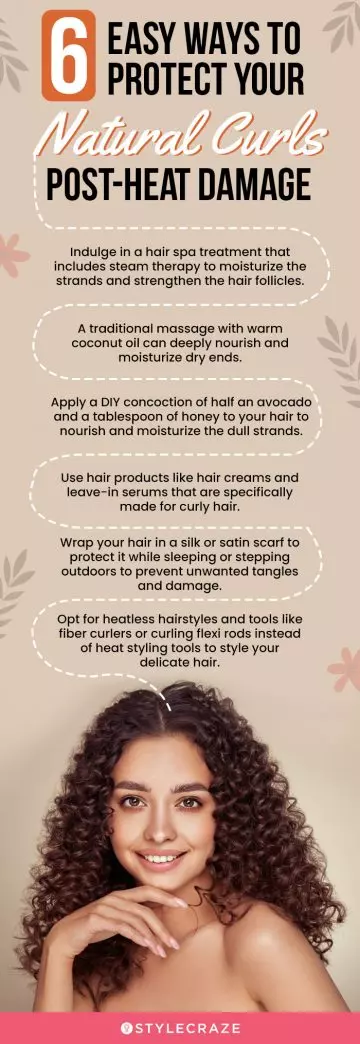
Illustration: StyleCraze Design Team
Heat-damaged curly hair becomes rough, dry, and shine-free as heat strips your hair of all its natural oils. Your curls also lose their shape and look somewhere between wavy and frizzy. The best way to get your curls rolling back is to go for nourishing treatments. From warm coconut oil and a hair spa to a DIY avocado mask, you can use a variety of home remedies for hair repair. The tips listed above work wonders to moisturize and nourish your hair. Keep following them, and you will see your hair getting back its natural curls in 2-3 months. Next time when you use a heat-styling tool, do not forget to apply a heat protectant for hair protection and make sure your flat iron does not exceed 220°F.
Frequently Asked Questions
Does heat permanently damage hair?
Yes. If heat styling has damaged your hair structure, the damage is permanent. However, there are several precautions you can take to avoid it or be patient to grow it out.
What does heat-damaged hair look like?
Heat-damaged hair has a dull and dry appearance. You may notice split ends, rough texture, and the hair becomes brittle.
Is it best to cut off damaged hair?
Yes. You can not reverse hair damage from heat styling. You may wait for it to grow out, but if there are split ends, it will damage the rest of your hair. Therefore, it is better to trim the damaged hair.
Key Takeaways
- Rough texture, weak hair, dry ends indicate heat-damaged curls.
- Coconut oil, avocado mask, moisturizing shampoo, and hair serum can help repair heat-damaged curls.
- Wearing a scarf, using a heat protectant, and opting for heatless hairstyles prevents damage to the hair.
- The ideal temperature of flat iron should be 220°F to minimize heat damage.
Learn how to get your curls back with this ultimate heat damage repair guide. Do as directed and your hair will start looking healthy again.
Personal Experience: Source
StyleCraze's articles are interwoven with authentic personal narratives that provide depth and resonance to our content. Below are the sources of the personal accounts referenced in this article.
i. How to get your curls back | ultimate heat damage repair guidehttps://www.youtube.com/watch?v=ap-NytuRVcM
References
Articles on StyleCraze are backed by verified information from peer-reviewed and academic research papers, reputed organizations, research institutions, and medical associations to ensure accuracy and relevance. Read our editorial policy to learn more.
- Heat-damaged evaluation of virgin hair
https://pubmed.ncbi.nlm.nih.gov/30861299/ - Alternative Protocol for Hair Damage Assessment and Comparison of Hair Care Treatments
https://www.ncbi.nlm.nih.gov/pmc/articles/PMC7276157/ - Hass Avocado Composition and Potential Health Effects
https://www.ncbi.nlm.nih.gov/pmc/articles/PMC3664913/ - Vitamin E in dermatology
https://www.ncbi.nlm.nih.gov/pmc/articles/PMC4976416/ - Influence of vitamin E acetate on stratum corneum hydration
https://pubmed.ncbi.nlm.nih.gov/9706379/ - Comparing the moisturizing effects of ascorbic acid and calcium ascorbate against that of tocopherol in emulsions
https://pubmed.ncbi.nlm.nih.gov/17256076/






